List of battery sizes
This article lists the sizes, shapes, and general characteristics of some common primary and secondary battery types in household and light industrial use.
Historically the term "battery" referred to a collection of electrochemical cells connected in series;[1] however, in modern times the term has come to refer to any collection of cells (or single cell) packaged in a container with external connections provided to power electrical devices,[2] leading to the variety of standardized form factors available today.
The long history of disposable dry cells means that many different manufacturer-specific and national standards were used to designate sizes, long before international standards were agreed upon. Technical standards for battery sizes and types are published by standards organizations such as the International Electrotechnical Commission (IEC) and American National Standards Institute (ANSI). Many popular sizes are still referred to by old standard or manufacturer designations, and some non-systematic designations have been included in current international standards due to wide use.
The complete nomenclature for a battery specifies size, chemistry, terminal arrangement, and special characteristics. The same physically interchangeable cell size or battery size may have widely different characteristics; physical interchangeability is not the sole factor in substituting a battery.
Standardization
The current IEC standards for portable primary (non-rechargeable) batteries bear the 60086 number. The relevant US standards are the ANSI C18 series, which are developed by a committee of the US National Electrical Manufacturers Association (NEMA).
Both standards have several parts that cover general principles, physical specifications, and safety. Designations by IEC and ANSI standards do not entirely agree, though harmonization is in progress. Also, manufacturers have their systems for identifying cell types, so cross-reference tables are useful to identify equivalent types from different manufacturers. [3]
Lead-acid automotive starting, lighting and ignition batteries have been standardized according to IEC standard 60095 and in North America by standards published by BCI.
Non-standard brand-specific names
Manufacturers may assign proprietary names and numbers to their batteries, disregarding common, colloquial, IEC, and ANSI naming conventions (see LR44 battery as an example). Often this is done to steer customers towards a specific brand, and away from competing or generic brands, by obfuscating the common name. For example, if a remote control needs a new battery and the battery compartment has the label, "Replace with CX472 type battery," many customers will buy that specific brand, not realizing that this is simply a brand name for a common type of battery. For example, British standard "U" series batteries were often sold under manufacturer prefixes such as "C", "SP", "HP", etc.; Ever Ready sold "U2" (D) batteries as "SP2" (standard-duty zinc carbon) and "HP2" (heavy duty zinc chloride).
On the other hand, with obscure battery types, the designation assigned by a specific brand will sometimes become the most common name for that battery type, as other manufacturers copy or modify the name so that customers recognize it.
Battery chemistry
The terminal voltage of a battery cell depends on the chemicals and materials used in its construction, and not on its physical size. For example, primary (non-rechargeable) alkaline batteries have a nominal voltage of 1.5 volts. Rechargeable NiCd (nickel cadmium) and NiMH (nickel metal hydride) typically output 1.25 volts per cell. Devices intended for use with primary batteries may not operate properly with these cells, given the reduction in voltage.
Dry Leclanché (carbon-zinc), alkaline and Lithium batteries are the most common modern types. Mercury batteries had stable cell terminal voltages around 1.35 volts. From the late 1940s until the mid-1990s, mercury batteries were made in many consumer and industrial sizes. They are no longer available since careless disposal can release toxic mercury into the environment. They have been replaced in some applications by zinc-air batteries, which also produce 1.35 volts.
The full battery designation identifies not only the size, shape and terminal layout of the battery but also the chemistry (and therefore the voltage per cell) and the number of cells in the battery. For example, a CR123 battery is always LiMnO2 ('Lithium') chemistry, in addition to its unique size.
The following tables give the common battery chemistry types for the current common sizes of batteries. See Battery chemistry for a list of other electrochemical systems.
Physical interchangeability
Cylindrical cells typically have a positive terminal nub at one end, and a flat negative terminal at the other. A cell with a nub on the positive terminal is called a button-top, and a cell without a positive nub is called a flat-top. Two different cells of the same nominal size, e.g. two 18650 cells, may have different diameter buttons if made by different manufacturers, and this can lead to incompatibility with devices. Flat-top cells cannot be used in series without modification or soldering into position, because the flat positive terminal of one cell cannot contact with the next cell's negative terminal. Rarely, however, a manufacturer may include tiny bumps on the negative terminal, so flat-tops can be used in series.
Cylindrical batteries
These are round batteries with height longer than their diameter. In zinc-carbon or alkaline types they produce around 1.5 V per cell when fresh. Other types[4] produce other voltages per package, as low as 1.2 V for rechargeable nickel-cadmium, up to 12 V for the A23 alkaline battery, a stack of 8 cells in the same overall format. This package has a positive nub terminal at the cap of the cell, and the negative terminal at the bottom of the can; the side of the can is not used as a terminal. The polarity of the can side may even change, according to their chemistry and whether the can is sealed from the positive or negative end. The internal cell construction may differ, common types are named bobbin, spiral and coiled.[5]
| Image (AA size for scale) |
Names | Typical capacity (mAh) |
Nominal voltage (V) |
Size, dia. × h. (mm) | Comments | |||
|---|---|---|---|---|---|---|---|---|
| Most common | Other common | IEC | ANSI | |||||
| 4⁄5AA | FLYCO Ni-Cd, Ni-Mh | 600–1500 | 1.2 | 14.0 × 40.0 | Same diameter as AA battery, used in small electronics, including electric shaver. | |||
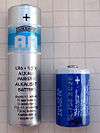 | 1⁄2AA | SAFT LS14250 Tadiran TL5101 UL142502P | CR14250 (LiMnO2) ER14250 (LiSOCl2) | 850–1200 | 3 (LiMnO2) 3.6 (LiSOCl2) | 14.0 × 25.0 (nom.) 14.5 × 25.0 (max.) |
Same diameter as AA battery, used in small electronics, including pulse oximeters, as well as use in some computer models (such as most pre-Intel Macintosh models and some older IBM PC compatibles) as the CMOS battery. Also used in US military MILES gear and DAGR. | |
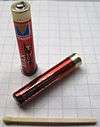 | AAAA | MX2500 Mini UM 6 (JIS) 単6 #9 (China) | LR8D425 (alkaline) | 25A (alkaline) | 625 (alkaline) | 1.5 | 8.3 × 42.5 | Sometimes used in pen flashlights, laser pointers, powered styluses, calculators, fishing lures. |
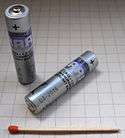 | AAA | U16 or HP16 (In the UK) Micro Microlight MN2400 MX2400 MV2400 Type 286 (Soviet Union/Russia) UM 4 (JIS)[6] 単4 #7 (China) 6135-99-117-3143 (NSN) | LR03 (alkaline) R03 (carbon–zinc) FR03 (LiFeS2) HR03 (NiMH) KR03 (NiCd) ZR03 (NiOOH) | 24A (alkaline) 24D (carbon–zinc) 24LF (LiFeS2) | 1200 (alkaline) 540 (carbon–zinc) 800–1000 (NiMH) 500 (NiZn) | 1.5 | 10.5 × 44.5 (0.41 × 1.75) |
Introduced 1911, but added to ANSI standard in 1959 Used in many household electronic devices |
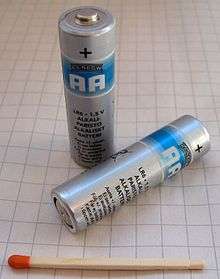 | AA | U12 or HP7 (In the UK) Pencil-sized Penlight Mignon MN1500 MX1500 MV1500 Type 316 (Soviet Union/Russia) UM 3 (JIS) 単3 #5 (China) 6135-99-052-0009 (NSN)(carbon-zinc) 6135-99-195-6708 (NSN)(alkaline) | LR6 (alkaline) R6 (carbon–zinc) FR6 (LiFeS2) HR6 (NiMH) KR6 (NiCd) ZR6 (NiOOH) | 15A (alkaline) 15D (carbon–zinc) 15LF (LiFeS2) 1.2H2 (NiMH) 1.2K2 (NiCd) | 2700 (alkaline) 1100 (carbon–zinc) 3000 (LiFeS2) 1700–2700 (NiMH) 600–1000 (NiCd) 1500 (NiZn) | 1.5 | 14.5 × 50.5 (0.57 × 1.99) |
Introduced 1907, but added to ANSI standard sizes in 1947. Used in many household electronic devices |
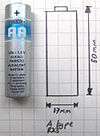 | A | R23 (carbon‑zinc) LR23 (alkaline) | 1.5 | 17 × 50 | More common as a NiCd or NiMH cell size than a primary size, popular in older laptop batteries and hobby battery packs.
Various fractional sizes are also available; e.g., 2⁄3 A and 4⁄5 A. | |||
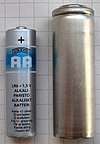 | B | U10 (UK) 336 (Russian Federation) | R12 (carbon‑zinc) LR12 (alkaline) | 8350 (alkaline) | 1.5 | 21.5 × 60 | Most commonly found within a European 4.5 volt lantern battery.
Not to be confused with the vacuum tube B battery. | |
 | C | U11 or HP11 (In the UK) MN1400 MX1400 Baby Type 343 (Soviet Union/Russia) BA-42 (US Military Spec WWII–1980s) UM 2 (JIS) 単2 #2 (China) 6135-99-199-4779 (NSN)(carbon-zinc) 6135-99-117-3212 (NSN)(alkaline) | LR14 (alkaline) R14 (carbon–zinc) HR14 (NiMH) KR14 (NiCd) ZR14 (NiOOH) | 14A (alkaline) 14D (carbon–zinc) | 8000 (alkaline) 3800 (carbon–zinc) 4500–6000 (NiMH) | 1.5 | 26.2 × 50 (1.03 × 1.97) |
Can be replaced with AA cell using a plastic sabot (size adaptor), with proportional loss of capacity. |
 | Sub-C | Type 332 (Soviet Union/ Russian Federation) | KR22C429 (NiCd) HR22C429 (NiMH) | 1200–2400 (NiCd) 1800–5000 (NiMH) | 1.2 | 22.2 × 42.9 (0.87 × 1.69) |
A common size for cordless tool battery packs. This size is also used in radio-controlled scale vehicle battery packs and some Soviet multimeters.
1⁄2-, 4⁄5- and 5⁄4-sub-C sizes (differing in length) are also available. Soviet 332 type can be replaced with R10 (#4, 927, BF, U8) or 1.5 V elements from 3 V 2xLR10 packs.[8][9] | |
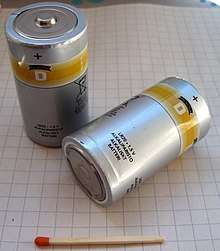 | D | U2 or HP2 (UK) Flashlight battery MN1300 MX1300 Mono Goliath Type 373 (Soviet Union/Russia) BA-30 (US Military Spec WWII–1980s) UM 1 (JIS) 単1 #1 (China) 6135-99-464-1938 (NSN)(carbon-zinc) 6135-99-109-9428 (NSN)(alkaline) | LR20 (alkaline) R20 (carbon–zinc) HR20 (NiMH) KR20 (Ni-Cd) ZR20 (NiOOH) | 13A (alkaline) 13D (carbon–zinc) | 12000 (alkaline) 8000 (carbon–zinc) 2200–11000 (NiMH) 2000–5500 (NiCd) | 1.5 | 34.2 × 61.5 (1.35 × 2.42) |
Introduced 1898 as the first flashlight battery. Can be replaced with AA cells using a plastic sabot (size adaptor), with proportional loss of capacity. |
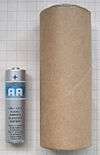 | F | R25 (carbon‑zinc) LR25 (alkaline) | 60 | 10500 (carbon‑zinc) 26000 (alkaline) | 1.5 | 33 × 91 | Four F cells are often found within 6 volt rectangular lantern batteries. | |
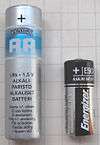 | N | Lady MN9100 UM 5 (JIS) 単5 E90 6135-99-661-4958 (NSN) | LR1 (alkaline) R1 (carbon‑zinc) HR1 (NiMH) KR1 (NiCd) | 910A (alkaline) 910D (carbon‑zinc) | 800–1000 (alkaline) 400 (carbon‑zinc) 350–500 (NiMH) | 1.5 | 12 × 30.2 | Rechargeable nickel–cadmium and nickel–metal hydride are far less common than other rechargeable sizes.[10]
Mercury batteries of the same dimensions are no longer manufactured. |
| A11 | A11 11A E11A MN11 L1016 4LR23 V11GA LR1016 |
4LR932 (alkaline) | 1811A (alkaline) | 55 (alkaline) | 6 | 10.3 × 16.0 | Usually contains a stack of four LR932 button cells shrink wrapped together. | |
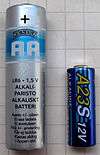 | A23 | V23GA 23A 23AE MN21 L1028 8LR23 LRV08 LR23A A23S 144 |
8LR932 (alkaline) | 1811A (alkaline) | 55 (alkaline) | 12 | 10.3 × 28.5 | Used in small RF devices such as key fob-style garage door openers, wireless doorbells, and keyless entry systems where only infrequent pulse current is used. Usually contains a stack of eight LR932 button cells shrink wrapped together. |
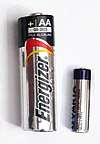 | A27 | GP27A MN27 L828 27A V27A A27BP G27A | 8LR732 (alkaline) | 22 (alkaline) | 12 | 8.0 × 28.2 | Used in small RF devices such as car alarm remote controls. Can also be found in some cigarette lighters. May be made of eight LR632 cells. | |
| BA5800 | BA5800/U (LiSOCl2) BA5800A/U (LiSO2) | 7500 (LiSO2) | LiSO2: 5.3 | 35.5 × 128.5 | Has both terminals at the same end and is roughly the size of two stacked D cells. Used in military hand-held devices such as the PLGR. | |||
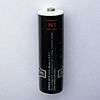 | Duplex | Ever Ready No. 8 | 2R10 | 3 | 21.8 × 74.6 | Internally contains two 1.5 V cells hence the nickname 'Duplex'. In Switzerland as of 2008, 2R10 batteries accounted for 0.003% of primary battery sales.[11] | ||
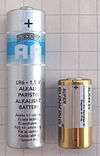 | 4SR44 | PX28A A544 K28A V34PX | 4LR44 (alkaline) | 110–150 (alkaline) 170–200 (silver‑oxide) | 6.2 (alkaline) 6.5 (silver‑oxide) | 13 × 25.2 | Used in film cameras, medical instruments, dog training devices. Often simply a stack of four SR44 (LR44) button cells shrink wrapped together. | |
Rectangular batteries
| Image (AA size for scale) |
Names | Typical capacity (mAh) |
Nominal voltage (V) |
Terminal layout | Dimensions (mm) |
Comments | |||
|---|---|---|---|---|---|---|---|---|---|
| Most common | Other common | IEC | ANSI | ||||||
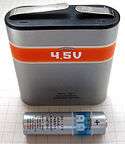 | 4.5-volt | 1289 (in the UK) Pocketable battery 4.5 V MN1203 Type 3336 (Soviet Union/Russia) | 3LR12 (alkaline) 3R12 (carbon‑zinc) | 3LR12 (alkaline) 3R12 (carbon‑zinc) | 6100 (alkaline) 1200 (carbon‑zinc) | Alkaline carbon‑zinc (3 cells): 4.5 | Two 6–7 mm wide metal strips +: shorter strip −: longer strip | H: 67 L: 62 W: 22 |
This battery, introduced in 1901, was very common in continental Europe until the 1970s. It usually contains three B cells in series.
In Switzerland as of 2008, 4.5-volt batteries account for only 1% of primary battery sales.[12] |
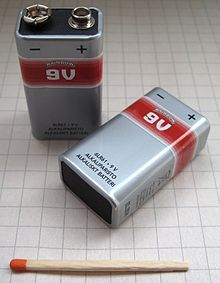 | 9-volt or E[13] | PP3 Radio battery Smoke alarm battery Square battery Transistor battery 006P MN1604 Type Krona (Soviet Union/Russia) | 6LR61 (alkaline) 6LP3146 (alkaline) [14] 6F22 (carbon‑zinc) 6KR61 (NiCd) 6HR61 (NiMH) | 1604A (alkaline) 1604D (carbon‑zinc) 1604LC (lithium) 7.2H5 (NiMH) 11604 (NiCd) 1604M (mercury, obsolete)[15] | 565 (alkaline) 400 (carbon‑zinc) 1,200 (lithium) 175–300 (NiMH) 120 (NiCd) 500 (lithium polymer rechargeable) 580 (mercury, obsolete) | Alkaline carbon‑zinc (6 cells): 9 Lithium (3 cells): 9 NiMH / NiCd (6, 7 or 8 cells): 7.2, 8.4 or 9.6[16] | Both on same end +: male clasp −: female clasp | H: 48.5 L: 26.5 W: 17.5 |
Added to ANSI standard in 1959.
Often contains six LR61 cells, which are similar to AAAA cells. |
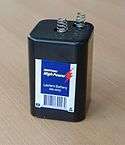 | 6-volt Lantern (Spring) | Lantern 6 V Spring top MN908 996 or PJ996 Energizer 529 | 4LR25Y (alkaline) 4R25 (carbon‑zinc) | 908A (alkaline) 908D (carbon‑zinc) | 26,000 (alkaline) 10,500 (carbon‑zinc) | Alkaline carbon‑zinc (4 cells): 6 | Springs, top +: corner spring −: center spring | H: 115 L: 68.2 W: 68.2 |
Spring terminals. Usually contains four F cells. |
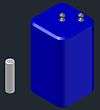 | Lantern (Screw) | Lantern 6 V Screw Top 6135-99-645-6443 (NSN) | 4R25X (carbon‑zinc) 4LR25X (alkaline) | 915 (carbon‑zinc) 915A (alkaline) | 10,500 (carbon‑zinc) 26,000 (alkaline) | 6 | Screw posts on top of battery. +: corner, −: center. Maximum diameter of the posts is 3.5 mm. | H: 109.5 L: 66.7 W: 66.7 |
Used in locations susceptible to high vibration/shock where connectors may be knocked off the terminals. |
 | Lantern (Big) | 918 R25-2 Big Lantern Double Lantern MN918 Energizer 521 | 4R25-2 (carbon‑zinc) 4LR25-2 (alkaline) | 918A | 22,000 (carbon‑zinc) 52,000 (alkaline) | 6 | Screw posts on top of battery. Labelled only, no physical keying for polarity. Maximum diameter of the posts is 4.2 mm spaced 75 mm apart. | H: 125.4 L: 132.5 W: 73 |
Used in locations susceptible to high vibration/shock where connectors may be knocked off the terminals. |
 | J | 7K67 | 4LR61 (alkaline) | 1412A (alkaline) | 625 (alkaline) | 6 | 6.5 mm² flat contacts, +: chamfered corner, −: top side | H: 48.5 L: 35.6 W: 9.18 |
Typically used in applications where the device in question must be flat, or where one should not be able to insert the battery in reverse polarity.
Often contains four LR61 cells, which are similar AAAA cells. |
Camera batteries
As well as other types, digital and film cameras often use specialized primary batteries to produce a compact product. Flashlights and portable electronic devices may also use these types.
| Image (AA size for scale) |
Names | Typical capacity (mAh) |
Nominal voltage (V) | Shape | Terminal layout | Dimensions | Comments | |||
|---|---|---|---|---|---|---|---|---|---|---|
| Most common | Other common | IEC | ANSI | |||||||
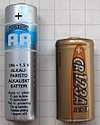 | CR123A | Camera battery 2⁄3A 123 CR123 17345 16340 CR-123A 6135-99-851-1379 (NSN) | CR17345 (lithium) | 5018LC (lithium) | 1500 (lithium) 700 (Li–ion rechargeable) | 3 (lithium) 3.6 (Li-ion) | Cylinder | +: Nub cylinder end −: Flat opposite end | H: 34.5 mm Ø: 17 mm[17] |
A lithium primary battery, not interchangeable with zinc types. A rechargeable lithium-ion version is available in the same size and is interchangeable in some uses. According to consumer packaging, replaces (BR)2⁄3A.
In Switzerland as of 2008, these batteries accounted for 16% of lithium camera battery sales.[11] |
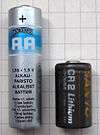 | CR2 | 15270 (Li-ion rechargeable, 800 mA) 15266 (Li-ion, 600 mA) 6135-99-606-3982 (NSN) | CR15H270[19] | 5046LC | 750 (lithium) 600/800 (Li-ion types) | 3 (lithium) 3.6 (Li-ion) | Cylinder | +: Nub cylinder end −: Flat opposite end | H: 27 mm Ø: 15.6 mm |
Standard discharge current: 10 mA
A common battery type in cameras and photographic equipment. In Switzerland as of 2008, these batteries accounted for 6% of lithium camera battery sales.[11] |
 | 2CR5 | EL2CR5 DL245 RL2CR5 KL2CR5 6135-99-577-2940 (NSN) | 2CR5 | 5032LC[20] | 1500 | 6 | Double cylinder. Keyed. | Both on one end. Terminal center spacing 16 mm. | H: 45 mm L: 34 mm W: 17 mm |
Commonly used in film and digital cameras. Shaped so that it can be inserted into a battery compartment only one way.
Contains 2 CR123A cells.[21] |
 | CR-P2 | BR-P2 223A CR17-33 5024LC | CR-P2 | 5024LC[22] | 1500 | 6 | Double cylinder. Keyed. | Both on one end. Terminal diameter: 8.7 mm Terminal center spacing: 16.8 mm. | H: 36 mm L: 35 mm W: 19.5 mm |
Shaped so that it can be inserted into a battery compartment only one way.
Typical mass: 37 g. They contain two 3 V cells exchangeable with CR123 cells. |
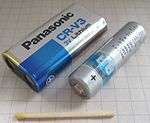 | CR-V3 | CRV3 RCR-V3 (Li-ion) | 5047LC 5047LF (primary)[23] | 3000 (lithium) 1300 (Li-ion) | 3 (lithium) 3.6 (Li-ion) | Double cylinder flat pack. Keyed. | Both on one end | H: 52.20 mm L: 28.05 mm W: 14.15 mm |
The same size as two R6 (AA) cells side by side. A rechargeable type is also made in this size.
May be used in some devices not explicitly designed for CR-V3, especially digital cameras. | |
| CP1 | DLCP1 DL-CP1C | CP3553[24] | 2300[25] | 3 | Prismatic. | Both on one end. | H: 57 mm L: 35 mm W: 7 mm |
Shaped so that it can be inserted into a battery compartment only one way.
No longer made by Duracell, nor listed in its official website, but still stocked as of 28 February 2017 by some re-sellers. Typical mass: 1.1 oz (31 g).[25] | ||
| 7R31 | Kodak K
7R31 538 |
4.5 | Cartridge | Negative along body, positive side of battery exposed for positive | Approx:
H: 19 mm L: 64 mm W: 16 mm |
Typically a cartridge of three mercury button cells for use in 110 format cameras. | ||||
Button cells - coin, watch
Lithium cells
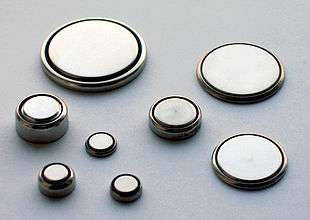
Coin-shaped cells are thin compared to their diameter. Polarity is usually stamped on the metal casing.
The IEC prefix "CR" denotes lithium manganese dioxide chemistry. Since LiMnO2 cells produce 3 volts there are no widely available alternative chemistries for a lithium coin battery. The "BR" prefix indicates a round lithium/carbon monofluoride cell. See lithium battery for discussion of the different performance characteristics. One LiMnO2 cell can replace two alkaline or silver-oxide cells.
IEC designation numbers indicate the physical dimensions of the cylindrical cell. Cells less than one centimeter in height are assigned four-digit numbers, where the first two digits are the diameter in millimeters, while the last two digits are the height in tenths of millimeters. Taller cells are assigned five-digit numbers, where the first two digits are the diameter in millimeters, followed by the last three digits indicating the height in tenths of millimeters.
All these lithium cells are rated nominally 3 volts (on-load), with open circuit voltage about 3.6 volts. Manufacturers may have their own part numbers for IEC standard size cells. The capacity listed is for a constant resistance discharge down to 2.0 volts per cell.[26]
| Names | Typical capacity (mAh) |
Standard discharge current (mA) |
Dimensions d × h (mm) |
Comments | |
|---|---|---|---|---|---|
| IEC | ANSI | ||||
| CR927 | 30 | 9.5 × 2.7 | Used extensively in blinkies. Also used in some LEGO toys. | ||
| CR1025 | 5033LC | 30 | 0.1 | 10 × 2.5 | |
| CR1130 | 70 | 11.5 × 3.0 | A rare battery, sometimes used in car security (car alarm/keyfob batteries), organizer (backup battery for PDA such as Psion etc.), and some pedometers.
Also known as DL1130, BR1130, KL1130, L1130, ECR1130, KCR1130, E-CR1130, KECR1130[27][28] | ||
| CR1216 | 5034LC | 25 | 0.1 | 12.5 × 1.6 | Used in some lighted watches and some LED decorator lights (electronic tea candles). |
| CR1220 | 5012LC | 35–40 | 0.1 (CR) 0.03 (BR) | 12.5 × 2.0 | Used in keychain LED flashlights, and in some digital cameras to keep the time and date function running even when the main battery is taken out of the camera.[29][30] |
| CR1225 | 5020LC | 50 | 0.2 | 12.5 × 2.5 | Maximum discharge current: 1 mA. Maximum pulse discharge current: 5 mA. |
| CR1616 | 50–55 | 0.1 | 16 × 1.6 | Used in automobile key remotes and in Game Boy cartridges (for powering the RAM for saved games). | |
| CR1620 | 5009LC | 75–78 | 0.1 | 16 × 2.0 | Used in automobile key remotes and early digital watches. |
| CR1632 | 140 (CR) 120 (BR) | 0.1 (CR) 0.03 (BR) | 16 × 3.2 | Used in automobile key remotes; e.g., Toyota Prius 2012. | |
| CR2012 | 55 | 0.1 | 20 × 1.2 | ||
| CR2016 | 5000LC | 90 | 0.1 (CR) 0.03 (BR) | 20 × 1.6 | Frequently used in digital watches. Often used in pairs instead of CR2032 for devices that require more than 3 V, like blue/white LED flashlights. |
| CR2020 | 115–125 | 20 × 2 | |||
| CR2025 | 5003LC | 160–165 | 0.2 | 20 × 2.5 | Frequently used in digital watches and automobile remotes. |
| CR2032 | 5004LC | 225 (CR) 190 (BR) | 0.2 (CR) 0.03 (BR) | 20 × 3.2 | Maximum discharge current: 3 mA. Maximum pulse discharge current: 15 mA.
This is also the most common lithium cell. Commonly used on computer motherboards as nonvolatile BIOS memory and real-time clock (RTC) backup batteries. Weighs around 2.9 g.[31] |
| CR2040 | 280 | 20 × 4.0 | Used in Skytronic PRO Audible Altimeter but also flow meters and organizers (as a memory backup battery). Has become obsolete and hard to find. Other names are BR2040, DL2040, ECR2040, E-CR2040, KCR2040, KECR2040, KL2040, L2040, L24. | ||
| CR2050 | 20 × 5.0 | Available. | |||
| CR2320 | 110–175 [32][33][34] | 23 × 2 | |||
| CR2325 | 165–210 | 23 × 2.5 | The most common battery size in Soviet/Russian electronic watches, calculators and remote controls. | ||
| CR2330 | 265 (CR) 255 (BR) | 0.2 (CR) 0.03 (BR) | 23 × 3.0 | ||
| BR2335[35] | 165 (BR) | 23 × 3.5 | |||
| CR2354 | 560 | 0.2 | 23 × 5.4 | ||
| CR2412 | 100 | 0.2 | 24.5 × 1.2 | ||
| CR2430 | 5011LC | 270–290 | 24.5 × 3.0 | Used in XBand Modem to save updates and profile data. | |
| CR2450 | 5029LC | 610–620 | 24.5 × 5.0 | Portable devices requiring high current (3.0 mA) and long shelf life (up to 10 years) | |
| CR2477 | 1000 | 0.2 | 24.5 × 7.7 | Has the highest capacity of lithium button cell batteries.[36] | |
| CR3032 | 500–560 (CR) 500 (BR) | 0.1-0.2 (CR) 0.03 (BR) | 30.0 × 3.2 | Continuous discharge current taken from Panasonic Catalog. | |
| CR11108 | 160 | 11.6 × 10.8 | Also called CR1/3N because it is 1⁄3rd the height of an alkaline N cell, and a stack of three of them will form a battery with the same dimensions as an N cell, but with 9 V terminal voltage. Such 9 V batteries in a single package do exist but are rare and only usually found in specialist applications; they can be referred to as 3CR1/3N. However, 2CR1/3N, a 6 V battery consisting internally of a stack of two CR1/3N and standardized by ANSI as 1406LC and by IEC as 2CR13252 (though some datasheets state it as 2CR11108 instead), is sold by Duracell (PX28L[37]), Energizer (L544, now obsolete[38]), and others.
A CR1/3N is also used by photographers instead of two LR44 batteries in cameras. | ||
Silver oxide and alkaline cells
Round button cells have heights less than their diameter. The metal can is the positive terminal, and the cap is the negative terminal.
Button cells are commonly used in electric watches, clocks, and timers. IEC batteries that meet the international IEC 60086-3 standard for watch batteries[39] carry a "W" suffix. Other uses include calculators, laser pointers, toys, LED "blinkies", and novelties.
IEC designation numbers indicate the physical dimensions of the cylindrical cell. Cells less than one centimeter in height are assigned 4-digit numbers, where the first 2 digits are the diameter in millimeters, while the last 2 digits are the height in tenths of millimeters. Taller cells are assigned 5-digit numbers, where the first 2 digits are the diameter in millimeters, followed by the last 3 digits indicating the height in tenths of millimeters.
.png)
In the IEC designations, cell types with an "SR" prefix use silver oxide chemistry and provide 1.55 volts, while the "LR" prefix batteries use alkaline chemistry and provide 1.5 volts. Common alternative manufacturer's prefixes for these two types are "SG" for silver oxide and "AG" for alkaline. Since there are no "common" names beyond the AG designation, many vendors use these four designations interchangeably for the same physical sized cell.
The functional differences are that silver oxide batteries typically have 50% greater capacity than alkaline chemistry, relatively slowly declining voltage during discharge compared to alkaline types of the same size, and superior leakage resistance. The ultimate energy capacity of a silver battery may be as much as twice that of an alkaline. Also, a silver cell with a flat discharge characteristic is preferable for devices that need a steady voltage, such as photographic light meters, and devices that will not operate below a certain voltage; for example, some digital calipers, which do not work below 1.38V.
Alkaline batteries are usually cheaper than silver oxide equivalents. Inexpensive devices are sometimes supplied fitted with alkaline batteries, though they would benefit from the use of silver oxide batteries. Exhausted silver oxide cells are often recycled to recover their precious metal content, whereas depleted alkaline cells are discarded with household trash or recycled, depending on the local practices.
Mercury batteries were formerly commonly made in button sizes for watches, but due to careless disposal and the resulting mercury pollution hazard, they are no longer available. This is also a concern for users of vintage camera equipment, which typically used a mercury button battery in the exposure meter for its very steady voltage characteristic. Substitute non-mercury batteries have been produced to replace certain discontinued mercury batteries, typically by incorporating a miniature voltage regulator to simulate the flat voltage discharge characteristics of the original batteries.
In the following table, sizes are shown for the silver-oxide IEC number; types and capacity are identified as "(L)" for alkaline, "(M)" for mercury (no longer manufactured), and "(S)" for silver-oxide. Some sizes may be interchangeably used in battery holders. For example, the 189/389 cell is 3.1 mm high and was designated 1131, while the 190/390 size is 3.0 mm high and was designated 1130, but a battery holder will accept either size.
| Names | Typical capacity (mAh) |
Dimensions dia × h (mm) |
Comments (L), alkaline (S), silver-oxide | |||
|---|---|---|---|---|---|---|
| Most common |
Other common | IEC | ANSI | |||
| SR41 | AG3/SG3/G3-A LR41 192/384[40]/392 6135-99-949-0402 (NSN)(S) QR41 |
LR736 (L) SR736 (S) | 1135SO (S) 1134SO (S) | 25–32 (L) 38–45 (S) | 7.9 × 3.6 | |
| SR42 | 242[41] 344[40]/350[42] 387S[43] |
SR1136 (KOH electrolyte, 344/350) SR1136S (NaOH electrolyte, 387S) | 1139SO | 63 (387S) 100 (344/350) | 11.6 × 3.6 | |
| SR43 | AG12/SG12 LR43 L1142 186/301[40]/386 6135-99-547-0573 (NSN)(S) | LR1142 (L) SR1142 (S) | 1133SO (S) 1132SO (S) | 80 (L) 120–125 (S) | 11.6 × 4.2 | |
| SR44 | AG13/SG13 LR44/LR154 6135-99-792-8475 (NSN)(alkaline) 6135-99-651-3240 (NSN)(S) A76/S76/EPX76 157/303[40]/357 1128MP, 208-904, A-76, A613, AG14, AG-14, CA18, CA19, CR44, D76A, G13A, G13-A, GDA76, GP76A, GPA7, GPA75, GPA76, GPS76A, KA, KA76, AG76, L1154, L1154C, L1154F, L1154G, L1154H, LR44G, LR44GD, LR44H, MS76H, PX76A, PX675A, RPX675, RW82, SB-F9, V13G, 357A | LR1154 (L) SR1154 (S) | 1166A (L) 1107SO (S) 1131SOP (S) | 110–150 (L) 170–200 (S) | 11.6 × 5.4 | Typical internal resistance: 8 ohms |
| SR45 | AG9/SG9 LR45 194/394/380[40] 6135-99-782-4675 (NSN)(S) | LR936 (L) SR936 (S) | 48 (L) 55–82 (S) | 9.5 × 3.6 | ||
| SR48 | AG5/SG5 LR48 L750 193/309[40]/393 | LR754 (L) SR754 (S) | 1136SO (S) 1137SO (S) | 52 (L) 70 (S) | 7.9 × 5.4 | |
| LR52 | A640PX, E640, EN640A, EPX640A, MR52, PX640, PX640A[44] | LR52 (L) MR52 (M) | 1126A (L)[45] | 335 (L)[45] | 15.8 × 11.1[45] | 1.5 V (L), 1.35 V (M)
No longer made by Duracell or Energizer, but still stocked by some re-sellers as of 26 February 2017[44] |
| SR54 | AG10/SG10/G10-A LR54 189/387/389/390[40] LR1130/SR1130 6135-99-796-0471 (NSN)(S) | LR1131 (L) SR1131 (S) | 1138SO (S) | 44–68 (L) 80–86 (S) | 11.6 × 3.1 | |
| SR55 | AG8/SG8 LR55 191/381[40]/391 LR1120/SR1120 | LR1121 (L) SR1121 (S) | 1160SO (S) | 40–42 (L) 55–67 (S) | 11.6 × 2.1 | |
| 365, 366[40], S16, 608 | SR1116SW | 1177SO [46] | 28–40[47][48] | 11.6 × 1.65 | 1.55 V | |
| SR56 | SR1126 | 11.6 × 2.6 | Listed in IEC 60086-2:2001, but apparently no longer manufactured by any major company. | |||
| SR57 | AG7/SG7 LR57 195 395(low-drain)[40]/399(high-drain)[49] LR927/SR927 SR927W/SR927SW/GR927 6135-99-796-0471 (NSN)(S) | LR926 (L) SR926 (S) | 1165SO (S) | 46 (L) 55–67 (S) | 9.5 × 2.6 | |
| SR58 | AG11/SG11 LR58 162/361/362[40] | LR721 (L) SR721 (S) | 1158SO (S) | 18–25 (L) 33–36 (S) | 7.9 × 2.1 | |
| SR59 | AG2/SG2 LR59 196/396/397[40] | LR726 (L) SR726 (S) | 1163SO (S) | 26 (L) 30 (S) | 7.9 × 2.6 | |
| SR60 | AG1/SG1 LR60 164/364[40] | LR621 (L) SR621 (S) | 1175SO (S) | 13 (L) 20 (S) | 6.8 × 2.1 | |
| SR62 | SR516SW 317[40] | LR516 (L) SR516 (S) | 11 (S) | 5.8 × 1.6 | ||
| SR63 | AG0/SG0 LR63 379[40] | LR521 (L) SR521 (S) | 10 (L) 18 (S) | 5.8 × 2.1 | ||
| SR64 | LR64 319[40] | LR527 (L) SR527 (S) | 12 (L) 20 (S) | 5.8 × 2.7 | ||
| SR65 | SR616SW 321[40] | LR65 Varta V321 | 6.8 × 1.65 | |||
| SR66 | AG4/SG4 LR66 177/376/377[40] SR626SW | LR626 (L) SR626 (S) | 1176SO (S) | 12–18 (L) 26 (S) | 6.8 × 2.6 | Commonly used in many wrist watches. |
| SR67 | 315[40] | SR716 (S) | 21 (S) | 7.9 × 1.65 | ||
| SR68 | SR916SW 373[40] | LR916 (L) SR916 (S) | 26 (S) | 9.5 × 1.6 | ||
| SR69 | AG6/SG6 LR69 171/370/371[40] LR920/SR920 | LR921 (L) SR921 (S) | 30 (L) 55 (S) | 9.5 × 2.1 | ||
| SR416 | SR416SW 337[40] | LR416 (L) SR416 (S) | 8 (S) | 4.8 × 1.6 | ||
| SR512 | 335[40] | SR512SW | 5.5 (S) | 5.8 × 1.3 | ||
| SR712 | SR712SW | SR712 (S) | 9 (S) | 7.9 × 1.3 | ||
| SR731 | SR731SW 24 329[40] | LR731 (L) SR731 (S) | 36 (S) | 7.9 × 3.1 | ||
| LR932 | LR932 (L) | 40 (L) | 9.3 × 3.2 | Rarely used independently. 8 of these in series are used to form an A23 battery. | ||
| LR9 | 625
V625U |
190 (L) | 15.5 × 6.0 | Its diameter is smaller on the other end. | ||
Zinc air cells (hearing aid)
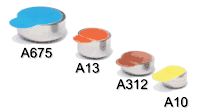
Miniature zinc-air batteries are button cells that use oxygen in air as a reactant and have very high capacity for their size. Each cell needs around 1 cc of air per minute at a 10 mA discharge rate. These cells are commonly used in hearing aids. A sealing tab keeps air out of the cell in storage; a few weeks after breaking the seal the electrolyte will dry out and the battery becomes unusable, regardless of use. Nominal voltage on discharge is 1.2 V.
| Names | Typical capacity (mAh) |
Dimensions dia. × h. (mm) |
Comments | |||
|---|---|---|---|---|---|---|
| Most common | Other common | IEC | ANSI | |||
| 5 | Red tab, AC5, ZA5 | PR63 | 7012ZD | 33 | 5.8 × 2.5 | Marked as "discontinued" in Energizer data sheet.[50] |
| 10 | Yellow tab, AC10, AC10/230,[51] DA10, DA230, ZA10[52][53] | PR70 | 7005ZD | 91 | 5.8 × 3.6 | |
| 13 | Orange tab, ZA13 | PR48 | 7000ZD | 280 | 7.9 × 5.4 | |
| 312 | Brown tab 6135-99-752-3528 (NSN) ZA312 | PR41 | 7002ZD | 160 | 7.9 × 3.6 | |
| 630 | DA630[51] | 7007Z | 1,000 | 15.6 × 6.2 | No longer listed by Duracell | |
| 675 | Blue tab, ZA675 | PR44 | 7003ZD | 600 | 11.6 × 5.4 | |
| AC41E | PR43 | 7001Z | 390 | 11.6 × 4.2 | Discontinued | |
Lithium-ion batteries (rechargeable)
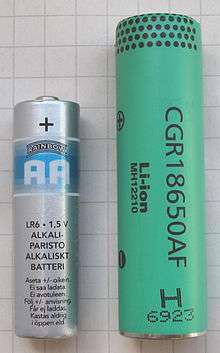
Cylindrical lithium-ion rechargeable battery
Lithium-ion rechargeable batteries are generally not interchangeable with primary types using different chemistry, though certain lithium primary cell sizes do have lithium-ion rechargeable equivalents. Most rechargeable cylindrical cells use a chemistry with a nominal voltage around 3.7 volts, but LiFePO
4 cells produce only 3.2 volts.
Generally for batteries with nominal voltage of 3.7 volts, full charge voltage(100% charged) is 4.2 volts and fully discharged voltage (0% charge remaining) is 3.0 volts.
Lithium-ion cells are made in various sizes, often assembled into packs for portable equipment.[54] Many types are also available with an internal protection circuit to prevent over-discharge and short-circuit damage. This can increase their physical length; for example, an 18650 is around 65 mm (2.56 in) long, but may be around 68 mm (2.68 in) long with an internal protection circuit. Safe and economic recharging requires a charger specified for these cells. Popular applications include laptop battery packs, electronic cigarettes, flashlights, electric vehicles, and cordless power tools.
Commonly-used designation numbers indicate the physical dimensions of the cylindrical cell, in a way similar to the system used for lithium button primary cells. The larger rechargeable cells are typically assigned five-digit numbers, where the first two digits are the (approximate) diameter in millimeters, followed by the last three digits indicating the (approximate) height in tenths of millimeters.
| Names | Typical capacity (mAh) |
Dimensions (mm) | Comments | ||
|---|---|---|---|---|---|
| Id.: | Other common | Diameter | Length | ||
| 07540 | 80–150 | 7.5 | 40 | Used in some Electronic cigarettes. | |
| 08570 | 280 | 8.5 | 57 | Used in some Electronic cigarettes. | |
| 10180 | Lithium ion 1⁄3 AAA | 90 | 10 | 18 | Sometimes called 1⁄3 AAA. Used in tiny flashlights. |
| 10280 | Lithium ion 2⁄3 AAA | 200 | 10 | 28 | Used in small flashlights. |
| 10440[55] | Lithium ion AAA | 250–350[56] | 10 | 44 | Same size as AAA cell. |
| 14250 | Lithium ion 1⁄2 AA | 300 | 14 | 25 | Same size as 1⁄2 AA cell. Used in the flashlight Lummi RAW. |
| 14430 | 400–600[57] | 14 | 43 | Used in solar garden lights, used in rechargeable shavers (e.g., some Philips/Norelco). | |
| 14500[58] | Lithium-ion AA | 700–1000[59][60] | 14 | 53 | Similar size as AA cell. Those with a protection circuit are slightly longer. Variations include rechargeable Kentli 1.5 V lithium AAs (2800 mAh) and non-rechargeable SAFT-brand primary cells (2600 mAh)[61][62] Used in many LED flashlights. Nominal voltage is 3.7 V. |
| 14650[63] | 940–1200[64] | 14 | 65 | Approximately 5⁄4 the length of a AA cell. | |
| 15270[65] | RCR2 | 450–600 | 15 | 27 | Substitute for CR2 primary lithium. Nominal voltage usually is 3 V. |
| 16340 | RCR123A | 550–800[66] | 16 | 34 | Alternate substitute for CR123A primary lithium.[67] Unprotected. (16 × 36, some protected versions[68]). |
| 16650 | 1600–2500[69] | 16 | 65 | Made by Sanyo and a few others, narrower version of 18650 cells. | |
| 17500[70][71] | A | 830–1200[72][73] | 17 | 50 | The same size as an A cell, and 1.5 times the length of a CR123A. SAFT-brand cells (3600 mAh) are non-rechargeable. |
| 17650 | 1200–1600[74] | 17 | 65 | Between the size of a 16650 and 18650. | |
| 17670[75][76] | 1250–1600[77] | 17 | 67 | Twice the length of a standard CR123A. | |
| 18350 | 700–1200[78] | 18 | 35 | [67] | |
| 18490[79] | 800–1400[80] | 18 | 49 | Slightly shorter than a 18500 cell. | |
| 18500[81][82] | 1100–2040[83] | 18 | 50 | About the same length as an AA cell, but larger diameter. | |
| 18650[84][85] | 168A | 1500–3500[86] | 18 | 65 | This cell type is used in many laptop computer batteries, cordless power tools, certain electric cars, electric kick scooters[87], most e-bikes (bicycles driven or supported by electric motors), electronic cigarettes,[88][89] and LED flashlights. Nominal voltage is 3.7 V.[67] |
| 20700[90] | 2800–4100[91] | 20 | 70 | Introduced by Sanyo/Panasonic for use in portable power tools as higher-power and higher-capacity successor for 18650 cells. | |
| 21700[92] | 21-70, 2170 | 3000–5000[93] | 21 | 70 | Announced by Samsung[94] and LG Chem in 2015 for use in electric bikes.[95] By January 2017, was being produced at Tesla Gigafactory 1 for the Tesla Model 3,[96] reaching an annual production rate of 1.8 billion cells annually (20 GWh per year) by mid-2018,[97] with a July 2019 Tesla forecast that they would ship 2 GWh of batteries in 2019.[98] |
| 25500[99] | 2500–5500[100] | 25 | 50 | ||
| 26500 | 26 | 50 | About the same dimension as a C cell. | ||
| 26650[101][102] | 2400–5750[103] | 26 | 65 | Popular size as[104] ANR26650 LiFePO 4 cell from A123 Systems for radio control hobby use. Also used in larger, high-powered LED flashlights and some Electronic cigarettes. | |
| 32600[105] | 3000–6100[106] | 32 | 60 | About the same dimension as a D cell. | |
| 32650[107] | 5000–6500[108] | 32 | 67.7 | Popular in larger LED flashlights. | |
| 38120 | 38120s, 38120HP | 8000-10000 | 38 | 120 | LiFePo4 3.2V. LiFePo4 properties: long lasting (2000+ cycles), safer, more stable, good continuous/peak discharge rates (3C/10C), less energy dense. These cylindrical cells are widely used in EVs including electric bikes, electric scooters, electric cars / hybrid electric cars, UPS batteries, storage batteries for solar power systems, starter batteries for cars & motorbikes etc. The Headway 38120HP cells are used in high discharge environments as they have very good continuous/peak discharge rates (10C/25C). Because four cells in series produces a voltage range similar to 6 cells of Lead-acids and their fire-resistant properties, they can be used to replace a 12V lead acid car battery. |
| 38140 | 38140s | 12000 | 38 | 140 | LiFePo4 3.2V. Slightly taller version of the 38120 cells, most often used in electric bikes. Height including the screw terminals: 154mm |
| 40152 | 40152s | 15000 | 40 | 152 | LiFePo4 3.2V. Largest cylindrical LiFePo4 cells. Height including the screw terminals: 167mm |
Obsolete batteries
These types are associated with legacy applications or no longer manufactured.
| Names | Typical capacity (mAh) |
Nominal voltage (V) | Terminal layout | Dimensions (mm) | Comments | |||
|---|---|---|---|---|---|---|---|---|
| Most common | Other common | IEC | ANSI | |||||
523_battery.jpg) |
PX21 | 3LR50 | 1306A | 580 (alkaline) | 4.5 | D: 17.1 H: 49.9 |
Used in cameras and Apple Macintosh computers (such as the 128K through 512K and similar). As the name suggests, this is often just 3 LR50 batteries stacked together. | |
531 |
PX19 | 3LR50 | 1307AP | 580 (alkaline) | 4.5 | D: 17.1 H: 58.3 |
A 523 with snap connectors attached to either end. Used in some older cameras, notably the Polaroid Automatic Land Camera packfilm models. | |
No. 6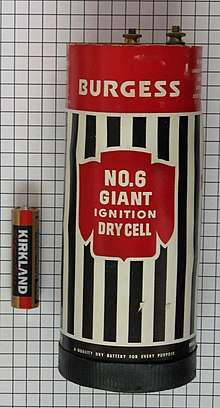 |
Ignition Cell, 6135-99-114-3446 (NSN) FLAG (in UK) |
R40 | 905 | 35000–40000 (carbon‑zinc) |
1.5 V | D: 67 H: 172 |
Typical 21st century uses for this high capacity dry cell named so aptly for its 6 inch height include school science experiments, and starting glow plug model engines and in antique equipment. This dry cell is commonly used in the UK for remote level crossing telephone handsets, where solar cells and rechargeable batteries have not been specified or retrofitted. These were formerly used in primary cell powered alarms (those without mains power) and associated bell ringing, servant or nurse call systems, ignition systems, telephones,[3] to improve voice quality on long lines to the local switch by increasing the off hook line voltage, impulse wound clocks (once a minute a mechanical movement pulses to advance electrically driven hands), and (in pairs) in WWII US Navy battle lanterns.
Modern cells identified as alkaline may be one or more 'D' cells in a holder. The terminal posts are threaded 8-32 (Unified Thread Standard), insulated terminal nuts are normally provided, conical profile helical spring terminals are added for specific applications. Stamped and formed sheet metal spring terminals for bare wire connections were supplied for use with telephones; e.g., the Western Electric 'Blue Bell' KS-6456 printed in blue ink on a grey paper and the Eveready 'Colombia Gray Label' printed in red ink on grey paper. +: centre; −: edge. | |
A Battery.jpg) |
Eveready 742 | 1.5 V | Metal tabs | H: 101.6 L: 63.5 W: 63.5 |
Used to provide power to the filament of a vacuum tube. | |||
B Battery.jpg) |
Eveready 762-S | 45 V | Threaded posts | H: 146 L: 104.8 W: 63.5 |
Used to supply plate voltage in vintage vacuum tube equipment. Origin of the term B+ for plate voltage power supplies.
Multiple B batteries may be connected in series to provide voltages as high as 300 V DC. Some versions have a tap at 22.5 volts. | |||
GB Battery.jpg) |
C Battery Eveready 761 |
1.5 to 9 V | Threaded posts or banana sockets | H: 76.2 L: 101.6 W: 31.75 |
Originally used in vintage vacuum tube equipment for grid bias.
Still popular for school science class use as a variable voltage supply as the current version has several taps at 1.5 volt intervals. | |||
15-volt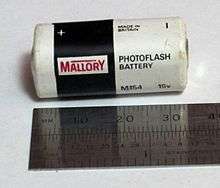 |
Eveready 504 Mallory M154 NEDA 220 Rayovac 220 |
10F15 (Zn/MnO2) | 220 | 65 | 15 V (10 cells) | Flat round (one each end) | H: 34.9 L: 15.1 W: 15.9 |
Used in older instruments[109] and old battery–capacitor flashes.
Still being manufactured as of 2020. |
22.5-volt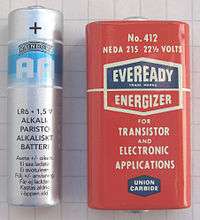 |
Eveready 412 | 15F20 (Zn/MnO2) | 215 | 140 | 22.5 V (15 cells) | Flat round (one each end) | H: 50 L: 25 W: 15 |
Used in older instruments.[110] the Regency TR-1 (first transistor radio) and old battery–capacitor flashes. |
30-volt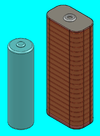 |
Eveready 413 | 20F20 (Zn/MnO2) | 210 | 140 | 30 V (20 cells) | Flat round (one each end) | H: 64 L: 25 W: 15 |
Used in older instruments.[111] |
45-volt |
Eveready 415 | 30F20 (Zn/MnO2) | 213 | 140 | 45 V (30 cells) | Both on same end | H: 91 L: 26 W: 15 |
Used in older instruments.[112] |
67.5-volt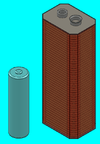 |
Eveready 416 | 217 | 140 | 67.5 V (46 cells) | Both on same end | H: 88 L: 33 W: 25 |
Used in older instruments.[113] | |
PP series
The PP (Power Pack) series was manufactured by Ever Ready in the UK (Eveready in the US). The series comprised multi-cell carbon-zinc batteries used for portable electronic devices. Most sizes are uncommon today; however, the PP3 size (and to a lesser extent PP8 and PP9, which are used in electric fencing and marine applications respectively) is readily available.[114] The PP4 was cylindrical; all the other types were rectangular. Most had snap terminals as seen on the common PP3 type. These came in two incompatible sizes, as is evident in some of the pictures below, those on larger, mostly older, battery types such as the PP9 being somewhat larger than those on the smaller batteries such as the PP3.
| Image (9-Volt or E size for scale) |
Names | Typical capacity (mAh) |
Nominal voltage (V) |
Dimensions (mm) |
Comments | |
|---|---|---|---|---|---|---|
| PP | Other common | |||||
| PP1 | 6 | H: 55.6 L: 65.5 W: 55.6 |
This battery had two snap connectors spaced 35 mm (1 3⁄8 in) apart. | |||
| PP3 | See 9-volt, above | |||||
 |
PP4 | 226 NEDA 1600 IEC 6F24 |
9 | H: 50.0 Diameter: 25.5 |
||
| PP6 | 246 NEDA 1602 6135-99-628-2361 (NSN) IEC 6F50-2 |
850 | 9 | H: 70.0 L: 36.0 W: 34.5 |
Center distance between terminals is max. 12.95 mm with both offset 7 mm nominal from the wider battery edge. Mass is 120 g. | |
| PP7 | 266 NEDA 1605 6135-99-914-1778 (NSN) IEC 6F90 |
2500 | 9 | H: 63 L: 46 W: 46 |
Center distance between terminals is max. 19.2 mm. Mass is 200 g. | |
| PP8 | SG8 "Fencer" |
6 | H: 200.8 L: 65.1 W: 51.6 |
This battery typically had two snap connectors; however, four connector versions are available. They were spaced 35 mm (1 3⁄8 in) apart. This type of battery is sometimes used in electric fencing applications. | ||
| PP9 | 276 NEDA 1603 6135-99-945-6814 (NSN) IEC 6F100 |
5000 | 9 | H: 81.0 L: 66.0 W: 52.0 |
This battery has two snap connectors spaced 35 mm (1 3⁄8 in) apart. | |
| PP10 | 9 | H: 226.0 L: 66.0 W: 66.0 |
This battery had two-pin connectors. They were a single ⌀3.2 mm negative pin and a single ⌀4.0 mm positive pin spaced 13.0 mm apart. | |||
 |
PP11 | 4.5 + 4.5 | H: 91.3 L: 65.1 W: 52.4 |
This battery contained two independent 4.5 V batteries, and had a four-pin connector. 9 V with a center tap was available by wiring in series. There were two ⌀3.2 mm negative pins spaced 9.5 mm apart and two ⌀4.0 mm positive pins spaced 14.3 mm apart. Negative and positive pins were spaced 18.1 mm apart. It was used in some early transistor radio amplifiers with a Class B output stage, allowing the loud speaker to be connected between the amplifier output and the battery center tap. | ||
See also
References
- Pistoia, Gianfranco (2005-01-25). Batteries for Portable Devices. Elsevier. p. 1. ISBN 0080455565. Retrieved 2016-03-18.
- Crompton, T. R. (2000-03-20). Battery Reference Book (third ed.). Newnes. p. Glossary 3. ISBN 0080499953. Retrieved 2016-03-18.
- David Linden, Thomas B. Reddy (ed). Handbook of Batteries, 3rd edition, McGraw-Hill, New York, 2002 ISBN 0-07-135978-8 chapter 4
- "Panasonic Interactive Short Form Catalog 2018" (PDF). eu.industrial.panasonic.com. Panasonic Corporation. 8 November 2018. Retrieved 26 September 2019.
- Kerouanto, Alain (February 2008). "Primary Lithium Batteries for Dummies!" (PDF). Poitiers, France: Saft, Lithium Batteries Division. Archived (PDF) from the original on 2019-08-11. Retrieved 2019-08-11. (93 pages)
- Heinz Albert Kiehne, Battery technology handbook,CRC Press, 2003 ISBN 0-8247-4249-4, page 374
- "Teardown of Kentli PH5 1.5 V Li-Ion AA battery". Jason Gin. Archived from the original on April 25, 2018. Retrieved April 24, 2018.
- "Battery R10 1.5V". Archived from the original on 2019-08-18. Retrieved 2019-08-18.
- File:Тестер ТЛ-4 с батарейками типа 332.JPG
- "Rechargeable N Size Battery". Robotroom.com. Archived from the original on October 18, 2010. Retrieved October 10, 2010.
- "INOBAT 2008 statistics" (PDF). Inobat.ch. Archived from the original (PDF) on 25 March 2012. Retrieved 23 February 2015.
- "Absatzzahlen 2008" (PDF). inobat.ch. Archived from the original (PDF) on March 25, 2012. Retrieved April 21, 2018.
- "Ansmann 9v block lithium batteries" (PDF). downloads.cdn.re. Archived (PDF) from the original on 2018-04-18. Retrieved 2018-04-17.
- https://d2ei442zrkqy2u.cloudfront.net/wp-content/uploads/2016/03/MN1604_6LP3146_US_CT1.pdf Archived 2018-05-27 at the Wayback Machine Datasheet, retrieved 2019 August 14
- "Energizer: Engineering Data" (PDF). Data.energizer.com. Archived (PDF) from the original on 30 September 2011. Retrieved 23 February 2015.
- "Maha Energy". Maha Energy. Archived from the original on 2013-10-15. Retrieved 2013-10-12.
- "Ultra 123 Lithium/Manganese Dioxide" (PDF). 2013-12-20. Archived (PDF) from the original on 2015-02-13. Retrieved 2016-05-24.
- "What kind of batteries do the SteriPEN products use? | Portable UV Purifier". Portable UV Purifier. Archived from the original on 2018-08-15. Retrieved 2018-01-04.
- IEC 60086-2: 2006
- "Energizer 1CR5" (PDF). Data.energizer.com. Archived (PDF) from the original on 30 September 2011. Retrieved 23 February 2015.
- "How to disassemble 2CR5?". www.candlepowerforums.com. Retrieved 2020-02-28.
- "Energizer 223" (PDF). Data.energizer.com. Archived (PDF) from the original on 30 September 2011. Retrieved 23 February 2015.
- "Energizer CRV3" (PDF). Datasheet.octopart.com. Archived (PDF) from the original on 30 September 2011. Retrieved 23 February 2015.
- "CP1 (CP1, CP3353) Duracell Ultra M3 Prismatic Battery for Digital Camera Battery". Small Battery Company. Archived from the original on 11 November 2016. Retrieved 28 February 2017.
- "Duracell CP1 Lithium Prismatic Digital Camera Battery". Amazon.com; MYBATTERYSUPPLIER. Archived from the original on 1 March 2017. Retrieved 28 February 2017.
- Archived September 27, 2009, at the Wayback Machine
- "powerstream data sheet" (PDF). Archived (PDF) from the original on 24 September 2015. Retrieved 5 September 2015.
- "CR1130 lithium button cell batteries. Battery equivalent to DL1130 BR1130 KL1130 L1130 ECR1130 KCR1130 E-CR1130 KECR1130". www.smallbattery.company.org.uk. Archived from the original on 2015-07-11. Retrieved 2015-09-05.
- Canon Powershot A590 IS Camera User Guide
- Canon Powershot S3 IS Camera User Guide
- "Energy catalog" (PDF). www.alliedelec.com. Archived (PDF) from the original on March 24, 2018. Retrieved April 21, 2018.
- "VARTA CR2320 BATTERY 3V LITHIUM (4008496043651)". Dealnay.com. Archived from the original on 2016-03-04. Retrieved 2015-02-23.
- "Varta CR2320, 06320101401: Amazon.co.uk: Electronics". Amazon.co.uk. Archived from the original on 2011-06-29. Retrieved 2015-02-23.
- "Online Catalog". BatteryShip.com. Archived from the original on 2019-03-20. Retrieved 2015-02-23.
- "Computer batteries" (PDF). www.mouser.com. Archived (PDF) from the original on February 2, 2019. Retrieved April 21, 2018.
- "Lithium Handbook: Industrial Batteries for Professionals" (PDF). eu.panasonic.com. Panasonic Corporation. 2015. Retrieved 26 September 2019.
- "Duracell PX28L" (PDF). Duracell. Archived (PDF) from the original on 20 February 2017. Retrieved 19 February 2017.
- "Energizer L544" (PDF). Data.energizer.com. Archived (PDF) from the original on 26 November 2018. Retrieved 15 February 2017.
- "International Standard" (PDF). Webstore.iec.ch. Archived (PDF) from the original on 6 March 2016. Retrieved 23 February 2015.
- "Renata SA: Silver Oxide 0% Mercury, Low drain E". www.renata.com. Archived from the original on 14 May 2019. Retrieved 14 May 2019.
- "344/350, Batteries and Battery Replacements m.csbatteries.com › 350-battery-344". CS Batteries. Archived from the original on 2017-04-07. Retrieved 2017-04-06.
- "Energizer 344/350" (PDF). Energizer. Archived (PDF) from the original on 2017-04-07. Retrieved 2017-02-19.
- "Energizer 387S" (PDF). Energizer. Archived (PDF) from the original on 2017-04-07. Retrieved 2017-02-19.
- "Exell A640PX 1.5V Alkaline Battery PX640A EN640A EPX640A LR52". Exell. Archived from the original on 2017-02-27. Retrieved 2017-02-26.
- "Energizer Industrial EN640A (discontinued)" (PDF). Energizer. Archived (PDF) from the original on 2017-02-27. Retrieved 2017-02-19.
- "Energizer 366 (obsolete)" (PDF). Energizer. Archived (PDF) from the original on 2017-02-27. Retrieved 2017-02-19.
- "366 Silver Oxide Button Cell Battery". BatteryMart.com. Archived from the original on 2015-02-28. Retrieved 2015-02-23.
- "Renata 366 Watch Battery MiniPack of 1 at Battery Force". Battery-force.co.uk. Archived from the original on 2015-01-11. Retrieved 2015-02-23.
- "Watch Battery Cross-reference Guide (Archived)" (PDF). www.energizer.com. Archived from the original (PDF) on December 5, 2014. Retrieved 23 February 2015.
- "Energizer No. AC5" (PDF). Data.energizer.com. Archived (PDF) from the original on 10 July 2011. Retrieved 23 February 2015.
- "Zinc Air Batteries". Memory Protection Devices. Archived from the original on 2018-10-04. Retrieved 2017-02-26.
- Piles bouton 1.5 V – piles electroniques. (n.d.)
- "équivalences et caractéristiques des piles". Piles bouton. Archived from the original on 2015-02-26. Retrieved 2015-02-23.
- "Portable battery pack manufacturing". Battery Bro. Archived from the original on 21 June 2015. Retrieved 21 June 2015.
- "LCR10440 Cylindrical Li-ion Battery Specification" (PDF). PowerStream. Guangzou Markyn Battery Co., Ltd. 9 August 2006. Retrieved 24 September 2019.
- "Soshine 10440 AAA 350mAh (Black)". lygte-info.dk. hkj. May 2017. Retrieved 24 September 2019.
- "Efest IMR14430 V1 600mAh (Red)". lygte-info.dk. hkj. January 2013. Retrieved 24 September 2019.
- Archived March 26, 2012, at the Wayback Machine
- "Panasonic: Lithium Ion UR14500P" (PDF). Industrial.panasonic.com. Archived (PDF) from the original on 11 January 2015. Retrieved 23 February 2015.
- "Keeppower 14500 1000mAh P1450C2 (Black) 2019". lygte-info.dk. hkj. March 2019. Retrieved 24 September 2019.
- Allan, Steve (17 December 2018). "Kentli Batteries [review]". YouTube. Retrieved 11 October 2019.
- "SAFT LS14500 3.6 V Primary lithium-thionyl chloride (Li-SOCl2) High Energy Density Cell" (PDF). Siemens. SAFT. September 2009. Retrieved 23 September 2019.
- "Lithium Ion UR14650 Datasheet" (PDF). Omnitron.cz. Panasonic. June 2016. Retrieved 26 September 2019.
- "KeepPower 14650 1100mAh protected li-ion rechargeable battery 3.7V P1465C". Keeppower. Retrieved 24 September 2019.
- "CR2: CR15270 Technical Datasheet". Ultralife. Ultralife Corporation. 2013. Retrieved 26 September 2019.
- "Vapcell 16340 800mAh 7A Button Top Battery". lygte-info.dk. hkj. May 2019. Retrieved 24 September 2019.
- "HDS Systems: Frequently Asked Questions - Answers to questions about our flashlights and technologies". Hdslights.com. 2005-08-13. Archived from the original on 2013-10-17. Retrieved 2015-02-23.
- "16340 Battery Warning!". E-cigarette-forum.com. 2009-08-21. Archived from the original on 2015-01-11. Retrieved 2015-02-23.
- "Sanyo UR16650ZTA 2500mAh (Magenta)". lygte-info.dk. hkj. September 2016. Retrieved 24 September 2019.
- Archived March 26, 2012, at the Wayback Machine
- "Panasonic CGR17500 Datasheet". datasheetpdf.com. Retrieved 22 September 2019.
- "KeepPower P1750C 17500 1200mAh P1750C Button Top Protected Li-ion Rechargeable Battery". ILLUMN. Retrieved 23 September 2019.
- "LS 17500 Product Datasheet" (PDF). saftbatteries.com. June 2019. Retrieved 22 September 2019.
- "EagleTac 17650 1600mAh (Black)". lygte-info.dk. hkj. January 2012. Retrieved 24 September 2019.
- "Lithium Ion Batteries (Individual Date Sheets): CGR17670HC: Cylindrical Model" (PDF). Liion.narod.ru. Archived (PDF) from the original on 4 March 2016. Retrieved 23 February 2015.
- "Panasonic CGR17670HC Datasheet". Datasheet-pdf.com. Panasonic. January 2000. Retrieved 24 September 2019.
- "AW 17670 1600mAh (Black) 2016". lygte-info.dk. hkj. May 2016. Retrieved 24 September 2019.
- "Aspire INR18350 1300mAh (Black-yellow)". lygte-info.dk. hkj. May 2017. Retrieved 24 September 2019.
- "Lithium Battery Specification MODEL: 18490-1100mAh-10C" (PDF). Conrad.com. Masspower Electronic Co., Ltd. 15 May 2014. Retrieved 26 September 2019.
- "Vapcell IMR18490 1400mAh (Yellow)". lygte-info.dk. hkj. May 2015. Retrieved 24 September 2019.
- Archived March 26, 2012, at the Wayback Machine
- "Specifications for NCR18500A Panasonic" (PDF). Master Instruments. Panasonic. Retrieved 24 September 2019.
- "Panasonic NCR18500A 2040mAh (Green)". lygte-info.dk. hkj. February 2017. Retrieved 24 September 2019.
- "Electronic Components & Solutions | Panasonic Industrial Devices" (PDF). Panasonic.com. Archived from the original (PDF) on 2013-06-03. Retrieved 2015-08-15.
- "Index of tested LiIon batteries". lygte-info.dk. hkj. 2019. Retrieved 24 September 2019.
- "Keeppower 18650 3600mAh P1836J (Black) 2019". lygte-info.dk. hkj. 2019. Retrieved 24 September 2019.
- "Xiaomi M365 Specifications". 31 July 2019. Archived from the original on 31 July 2019. Retrieved 31 July 2019.
- "Reddit Electronic Cigarette Wiki". reddit.com. Archived from the original on 16 April 2015. Retrieved 16 April 2015.
- "List of Battery Tests". e-cigarette-forum. 22 June 2015. Retrieved 24 September 2019.
- "Panasonic NCR20700B Data Sheet". datasheetspdf.com. SANYO Electric Co., Ltd. Retrieved 24 September 2019.
- "Keeppower IMR20700 4250mAh UH2042 (Black) 2017". lygte-info.dk. hkj. September 2017. Retrieved 24 September 2019.
- "SPECIFICATION OF PRODUCT INR21700-40T Lithium-ion rechargeable cell for power tools" (PDF). vapcelltech. Samsung SDI Co., Ltd. December 2017. Retrieved 24 September 2019.
- "Bench Test Results: Vapcell Purple 10A 5000mAh 21700…10A but overrated mAh, runs longer than Samsung". e-cigarette-forum. 17 November 2017. Retrieved 24 September 2019.
- "Samsung SDI Unveils E-bike Battery Capable of 100km on Single Charge". Be Korea-savvy. 26 August 2015. Archived from the original on 26 December 2015. Retrieved 31 August 2016.
- "E-Bike Report From Eurobike: New Tech & New Batteries". Electric Bike Report. 10 September 2015. Archived from the original on 20 August 2016. Retrieved 31 August 2016.
- "Tesla Gigafactory tour roundup and tidbits: 'This is the coolest factory in the world'". Archived from the original on 2016-09-17. Retrieved 2016-07-29.
- "Tesla Gigafactory". Archived from the original on 1 September 2018. Retrieved 21 October 2019.
- Tesla Sets Record for EV Deliveries, but Losses and Solar Shrinkage Endure : 2019 is supposed to be “the year of the solar roof,” but Tesla’s solar business continues to wither, Eric Wesoff, 25 July 2019, accessed 23 October 2019
- Archived March 12, 2012, at the Wayback Machine
- "FastTech 25500 3.7V 5500mAh Rechargeable Lithium Battery". FastTech. Archived from the original on 23 September 2019. Retrieved 22 September 2019.
- "CGR26650B" (PDF). www.actec.dk. Archived from the original (PDF) on March 12, 2012. Retrieved February 4, 2012.
- "26650 Battery Bench Test Results and New Ratings Table". e-cigarette-forum. 20 January 2016. Archived from the original on 2019-09-24. Retrieved 24 September 2019.
- "Shockli IMR26650 5500mAh (Black) 2017". lygte-info.dk. hkj. January 2017. Retrieved 24 September 2019.
- "NEC Energy Solutions Battery Modules". Buya123batteries.com. 2015-01-27. Archived from the original on 2015-05-26. Retrieved 2015-02-23.
- Archived March 12, 2012, at the Wayback Machine
- "EnerPower+ 32600 6000mAh (Yellow)". lygte-info.dk/. hkj. March 2017. Retrieved 24 September 2019.
- "Product Specification LFP-32650 LiFePO4 Battery" (PDF). batteryspace.com. AA Portable Power Corp. Retrieved 24 September 2019.
- "Soshine 32650 6500mAh (Black)". lygte-info.dk. hjk. February 2018. Retrieved 24 September 2019.
- "Energizer No. 504" (PDF). Datasheet.octopart.com. Archived (PDF) from the original on 5 March 2016. Retrieved 23 February 2015.
- "Energizer No. 412" (PDF). Datasheet.octopart.com. Archived (PDF) from the original on 5 March 2016. Retrieved 23 February 2015.
- "Energizer No. 413" (PDF). Datasheet.octopart.com. Archived (PDF) from the original on 14 October 2013. Retrieved 23 February 2015.
- "Energizer No. 415" (PDF). Datasheet.octopart.com. Archived (PDF) from the original on 4 March 2016. Retrieved 23 February 2015.
- "Energizer No. 416" (PDF). Datasheet.octopart.com. Archived (PDF) from the original on 5 March 2016. Retrieved 23 February 2015.
- Thomas Roy Crompton Battery Reference Book 3rd edition , Newnes, 2000, ISBN 0-7506-4625-X, page 54-11
Further reading
- IEC 60086-1: Primary batteries - Part 1: General
- IEC 60086-2: Primary batteries - Part 2: Physical and electrical specifications
- IEC 60086-3: Primary batteries - Part 3: Watch batteries
- IEC 60086-4: Primary batteries - Part 4: Safety of lithium batteries
- ANSI C18.1, Part 1 Portable Primary Cells and Batteries With Aqueous Electrolyte - General and Specifications
- ANSI C18.1, Part 2 Portable Primary Cells and Batteries With Aqueous Electrolyte Safety Standard
- ANSI C18.2, Part 1 Portable Rechargeable Cells and Batteries - General and Specifications
- ANSI C18.2, Part 2 Portable Rechargeable Cells and Batteries Safety Standard
- ANSI C18.3, Part 1 Portable lithium Primary Cells and Batteries - General and Specifications
- ANSI C18.3, Part 2 Portable lithium Primary Cells and Batteries Safety Standard
- MOD Defence Standard 61-017 The Selection and Introduction of Batteries and Fuel Cells for Service Use
- MOD Defence Standard 61-021 Generic Specification for Batteries
External links
| Wikimedia Commons has media related to Batteries by form factor. |
- A growing list of battery equivalents and details. Courtesy of the Highfields Amateur Radio Club (Cardiff, UK). (Archived on 31 Jan 2016)
- Duracell Technical OEM Data Sheets
- Energizer/Eveready Data Sheets
- Energizer/Eveready European Data Sheets
- Energizer/Eveready Obsolete Battery Data Sheets
- Brand Neutral Drawings Of Common Batteries Based On ANSI C18-2007
- EU Report on battery labelling
- Batteries CROSS-REFERENCE INDEX
- What is an 18650 battery?
